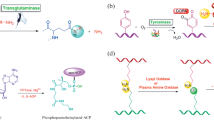Abstract
The present work focuses on the development of biomaterials that support the adhesion and the proliferation of adipose-tissue derived stem cells. Therefore, gelatin and starch are selected as starting materials. Both hydrogel building blocks are of great interest as they provide a general chemical structure comparable to the protein and the polysaccharide constituting part of the extracellular matrix. Crosslinkable side groups are incorporated on both biopolymers to enable the subsequent chemical crosslinking, thereby ensuring their stability at physiological temperature. An in vitro cellular assay revealed that the hydrogels developed are biocompatible and supported cell adhesion of adipose-tissue derived mesenchymal stem cells. The presence of the starch phase tempered the adhesion resulting in local cell detachment. The results thus indicate that by carefully varying the ratio of the two building blocks, hydrogels can be developed possessing a controllable cell adhesion behavior.
Graphical Abstract





Similar content being viewed by others
References
Atala A. Regenerative medicine strategies. J Pediatr Surg. 2012;47(1):17–28.
Ratner BD HA, Schoen F,Lemons J.. Biomaterials Science An Introduction to Materials in Medicine Science 2nd ed. Elsevier; 2004.
Langer R. Tissue engineering: a new field and its challenges. Pharm Res. 1997;14(7):840–1.
West JL. Protein-patterned hydrogels: customized cell microenvironments. Nat Mater. 2011;10:727–9.
Kim B-S, Mooney DJ. Development of biocompatible synthetic extracellular matrices for tissue engineering. Trends Biotechnol. 1998;16(5):224–30.
Fu Y, Xu K, Zheng X, Giacomin AJ, Mix AW, Kao WJ. 3D cell entrapment in crosslinked thiolated gelatin-poly(ethylene glycol) diacrylate hydrogels. Biomaterials. 2012;33(1):48–58.
Marler JJ, Upton J, Langer R, Vacanti JP. Transplantation of cells in matrices for tissue regeneration. Adv Drug Deliv Rev. 1998;33(1–2):165–82.
Drury JL, Mooney DJ. Hydrogels for tissue engineering: scaffold design variables and applications. Biomaterials. 2003;24(24):4337–51.
Vlierberghe SV, Schacht E, Dubruel P. Reversible gelatin-based hydrogels: finetuning of material properties. Eur Polym J. 2011;47(5):1039–47.
Peters K, Salamon A, Van Vlierberghe S, Rychly J, Kreutzer M, Neumann H-G, et al. A new approach for adipose tissue regeneration based on human mesenchymal stem cells in contact to hydrogels—an in vitro study. Adv Eng Mater. 2009;11(10):B155–61.
Salamon A, van Vlierberghe S, van Nieuwenhove I, Baudisch F, Graulus G-J, Benecke V, et al. Gelatin-based hydrogels promote chondrogenic differentiation of human adipose tissue-derived mesenchymal stem cells in vitro. Materials. 2014;7(2):1342–59.
Van Vlierberghe S, Vanderleyden E, Dubruel P, De Vos F, Schacht E. Affinity study of novel gelatin cell carriers for fibronectin. Macromol Biosci. 2009;9(11):1105–15.
Van Vlierberghe S, Schacht E, Dubruel P. Reversible gelatin-based hydrogels: finetuning of material properties. Eur Polym J. 2011;47(5):1039–47.
Van Vlierberghe S, Fritzinger B, Martins JC, Dubruel P. Hydrogel network formation revised: high-resolution magic angle spinning nuclear magnetic resonance as a powerful tool for measuring absolute hydrogel cross-link efficiencies. Appl Spectrosc. 2010;64(10):1176–80.
Van Vlierberghe S, Dubruel P, Schacht E. Biopolymer-based hydrogels as scaffolds for tissue engineering applications: a review. Biomacromolecules. 2011;12(5):1387–408.
Van Vlierberghe S, Dubruel P, Lippens E, Masschaele B, Van Hoorebeke L, Cornelissen M, et al. Toward modulating the architecture of hydrogel scaffolds: curtains versus channels. J Mater Sci–Mat Med. 2008;19(4):1459–66.
Van Vlierberghe S, Cnudde V, Dubruel P, Masschaele B, Cosijns A, De Paepe I, et al. Porous gelatin hydrogels: 1. Cryogenic formation and structure analysis. Biomacromolecules. 2007;8(2):331–7.
Van Nieuwenhove I, Stubbe B, Graulus G-J, Van Vlierberghe S, Dubruel P. Protein functionalization revised: N-tert-butoxycarbonylation as elegant tool to circumvent protein crosslinking. Macromol Rapid Commun. 2014;35(15):1351–5.
Dubruel P, Unger R, Van Vlierberghe S, Cnudde V, Jacobs PJS, Schacht E, et al. Porous gelatin hydrogels: 2. In vitro cell interaction study. Biomacromolecules. 2007;8(2):338–44.
Silva NA, Sousa RA, Pires AO, Sousa N, Salgado AJ, Reis RL. Interactions between Schwann and olfactory ensheathing cells with a starch/polycaprolactone scaffold aimed at spinal cord injury repair. J Biomed Mater Res, Part A. 2012;100A(2):470–6.
Rodrigues A, Emeje M. Recent applications of starch derivatives in nanodrug delivery. Carbohydr Polym. 2012;87(2):987–94.
Mendez-Ferrer S, Michurina TV, Ferraro F, Mazloom AR, MacArthur BD, Lira SA, et al. Mesenchymal and haematopoietic stem cells form a unique bone marrow niche. Nature. 2010;466(7308):829–59.
Sacchetti B, Funari A, Michienzi S, Di Cesare S, Piersanti S, Saggio I, et al. Self-renewing osteoprogenitors in bone marrow sinusoids can organize a hematopoietic microenvironment. Cell. 2007;131(2):324–36.
James AW, Zara JN, Zhang XL, Askarinam A, Goyal R, Chiang M, et al. Perivascular stem cells: a prospectively purified mesenchymal stem cell population for bone tissue engineering. Stem Cells Trans Med. 2012;1(6):510–9.
Acknowledgments
The authors would like to acknowledge Ghent University for financial support in the frameworks of the UGent-GOA Project 2010-2015 (BOF10/GOA/005, Biomedical Engineering for Improved Diagnosis and Patient-Tailored Treatment of Aortic Aneurysms and Dissection) and the UGent Multidisciplinary Research Partnership Nano- and biophotonics (2010–2014). Ine Van Nieuwenhove would like to thank University Ghent for the financial support under the form of a doctoral fellowship ‘BOF-mandaat’. Sandra Van Vlierberghe would like to acknowledge the Research Foundation-Flanders (FWO, Belgium) for financial support under the form of a post-doctoral fellowship and a Research Grant (‘Development of the ideal tissue engineering scaffold by merging state-of-the-art processing techniques’, FWO Krediet aan Navorsers). Peter Dubruel would like to acknowledge the Alexander von Humboldt Foundation for the financial support under the form of a granted Research Fellowship. All authors acknowledge the funding obtained for the EuroTransBio (ETB) Project ETB-2012-33 “Autologous Stem Cell-Enriched Scaffolds for Soft Tissue Regeneration—ASCaffolds”.
Author information
Authors and Affiliations
Corresponding authors
Rights and permissions
About this article
Cite this article
Van Nieuwenhove, I., Van Vlierberghe, S., Salamon, A. et al. Photo-crosslinkable biopolymers targeting stem cell adhesion and proliferation: the case study of gelatin and starch-based IPNs. J Mater Sci: Mater Med 26, 104 (2015). https://doi.org/10.1007/s10856-015-5424-4
Received:
Accepted:
Published:
DOI: https://doi.org/10.1007/s10856-015-5424-4




